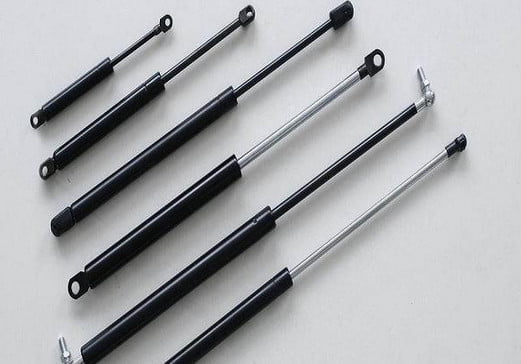Compressed gas spring is an industrial accessory that can support, buffer, brake, adjust height and adjust angle.
The compressed gas spring is mainly composed of the following parts: pressure cylinder, piston rod, piston, sealing guide sleeve, filling, control elements in the cylinder and control elements and joints outside the cylinder. The principle is to fill the closed pressure cylinder with inert gas or oil-air mixture, and the pressure in the cavity is several times or dozens of times the atmospheric pressure. When the compressed gas spring acts, the pressure difference between the two sides of the piston is used to realize the movement of the piston rod. Due to the difference in basic principles, air springs have obvious advantages over ordinary springs: relatively slow speed, little change in power, and easy control.
Various parameters of compressed gas springs:
⑴ spring wire diameter d: the diameter of the steel wire used to manufacture the spring.
(2) Spring outer diameter D2: the outer diameter of the spring.
(3) Spring inner diameter D1: the minimum outer diameter of the spring.
⑷ spring diameter D: the average diameter of the spring.
Their calculation formula is: D=(D2+D1)÷2=D1+d=D2-d
⑸ Pitch t: Except for the support ring, the axial distance between the corresponding points of the two adjacent rings of the spring on the middle diameter becomes the pitch, which is represented by t.
⑹ Effective number of turns n: the number of turns that the spring can keep the same pitch.
⑺ Number of supporting circles n2: In order to make the spring work evenly and ensure that the axis is vertical to the end face, both ends of the spring are often tightened during manufacture. The number of tight turns only serves as a support and is called a support ring.
Generally, there are 1.5d, 2d, 2.5d, and 2d is commonly used.
⑻ The total number of turns n1: the sum of the effective number of turns and the support turns. That is, n1=n+n2.
⑼Free height H0: The height of the spring without external force.
Calculated by the following formula: H0=nt+(n2-0.5) d=nt+1.5d (when n2=2)
⑽Spring unwinding length L: the length of the steel wire required for winding the spring.
L≈n1 (ЛD2)2+n2 (compression spring) L=ЛD2 n+ hook extension length (tension spring)
⑾ Spiral direction: There are left and right rotations, usually right-handed, and right-handed is generally used if the drawings are not indicated.
⑿ Spring winding ratio: the ratio of the middle diameter D to the steel wire diameter d.
Compression gas spring installation method:
The position of the piston rod of the compressed gas spring must be downward according to the loading time to reduce friction and ensure good damping quality and cushioning performance. When the retraction spring is pressed, it must be moved past the midpoint line when the spring closes, otherwise the door will normally be pushed open. When choosing a compressed gas spring, before determining the installation location, you should first select according to the model and specification of the specification. Compression gas springs should not be affected by tilting or lateral forces during operation. The piston rod is not painted nor does it allow the air spring to be installed in the desired position first and then painted. The compressed gas spring is a high-pressure product, so do not disassemble it at will. It is strictly forbidden to bake and crush the compressed gas spring, and the compressed gas spring plug rod cannot be rotated to the left.

